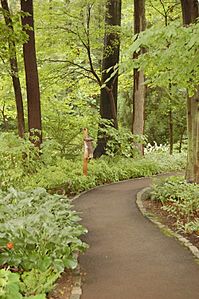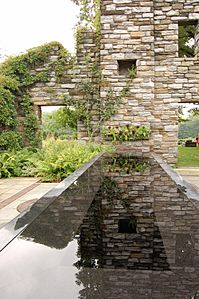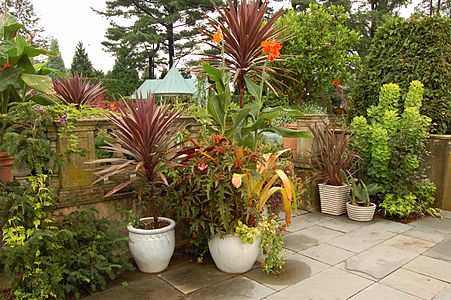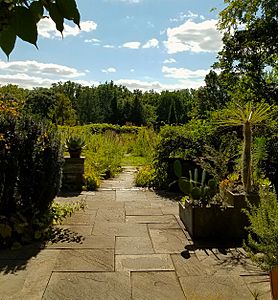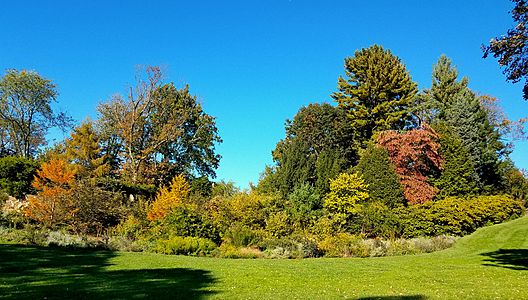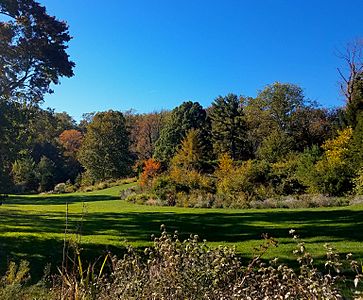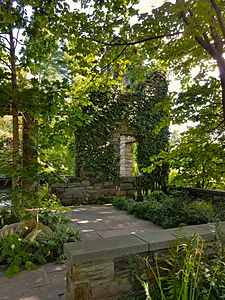Chanticleer Garden facts for kids
Quick facts for kids |
|
|
Chanticleer
|
|

Chanticleer, the main house, April 2007
|
|
| Location | 786 Church Road in Wayne, Pennsylvania |
|---|---|
| Area | 48 acres (19 ha) |
| Built | 1912 |
| Architect | Zantzinger, Borie and Medary |
| Architectural style | Colonial Revival, Colonial, Pastoral |
| NRHP reference No. | 84003350 |
| Added to NRHP | July 24, 1984 |
Chanticleer Garden is a beautiful 48-acre botanical garden in Wayne, Pennsylvania. It's a special place where you can relax, walk, and even have a picnic! The garden used to be a private home, but it opened to the public in 1993. You can visit Chanticleer from April through October each year. The house and grounds were added to the National Register of Historic Places in 1984.
History of Chanticleer Garden
The Chanticleer estate was built in 1912. It was a summer home for Christine Penrose and Adolph G. Rosengarten, Sr.. Mr. Rosengarten was in charge of a company that made medicines. His family started the company in 1822.
Later, their son, Adolph G. Rosengarten, Jr., inherited the estate. He wanted Chanticleer to become a public garden for everyone to enjoy. So, he set up a special foundation to make sure this would happen.
What's in a Name?
The name "Chanticleer" comes from a French word. It means "rooster"! You can see a carved stone rooster at the entrance gate. You might even spot other rooster decorations around the garden.
Adolph G. Rosengarten, Jr. hired Christopher Woods to help create the garden. After Mr. Rosengarten, Jr. passed away in 1990, Christopher Woods became the first Executive Director. He made many changes to the garden. He even took down one of the old stone houses to create a new area called "The Ruin".
Exploring the Gardens
Chanticleer Garden has many open lawns and large trees. It's divided into different areas, each with its own unique feel.
- Chanticleer House: This is the main house. It has a lovely open-air porch where visitors can sit and relax. It connects to the Teacup Garden.
- Asian Woods: This area was started in 1995. It has many plants from Korea, Japan, and China. It's designed to look like an American woodland garden.
- Pond Garden: This is a large, round pond built in the 1970s. The water acts like a mirror, reflecting the beautiful trees around it.
- Teacup Garden: This is a smaller garden. It's the first area you see when you enter the property.
- Minder Woods: This part of the garden is full of tall red oaks and dark green pine trees. You can explore it by walking on winding stone paths.
- Tennis Court Garden: The old tennis court on the estate has been turned into a lively and colorful garden.
- "The Ruin" Garden: This area used to be a house built in 1925. It was taken down in 1999 to create a series of interesting spaces. These include pools and fountains.
- Gravel Garden: This garden has several small spaces connected by steps. It's home to many rare plants that are not usually found in this area.
- Cutting Garden: This is a traditional cottage garden. It has arches made from metal bars and driftwood. These arches are perfect for climbing vines like clematis.
- Vegetable Garden: Here you'll find a simple, traditional American vegetable garden. Rustic benches make it a nice place to sit.
- Bell's Run: This area has rolling lawns, a stream, and a working waterwheel from the 1940s.
- Bell's Woodland: Opened in 2012, this section mainly features plants found in eastern North American forests.
- Bulb Meadow: This hillside meadow is known for its beautiful Spanish bluebells and delicate daffodils.
The grounds
See also
 In Spanish: Chanticleer Garden para niños
In Spanish: Chanticleer Garden para niños


